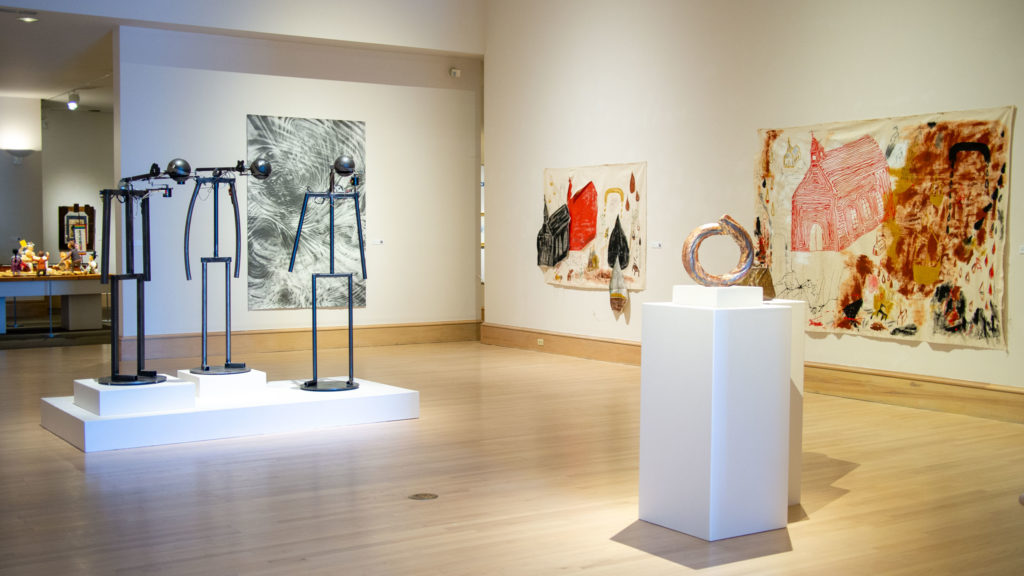Situated in the heart of the Blount Cultural Park in Montgomery, Alabama, is the Montgomery Museum of Fine Arts. For nearly a century, the Museum has housed a magnificent collection of artworks from American to African art, Old Master prints, glass, and works by local artists. This blog takes us behind the scenes of two new exhibitions on view—the 44th Montgomery Art Guild Museum Exhibition and Marguerite Edwards: Public Faces and Private Spaces, while also looking at the overall process for bringing an exhibition to the museum.
Planning, Mapping, and Coordinating
The Museum programs the exhibition cycle up to three years in advance. Months or years before an upcoming exhibition, the curators research many artworks by viewing them in person or through books, catalogues, and articles, For exhibitions such as the 44th Montgomery Art Guild Museum Exhibition and Marguerite Edwards: Public Faces and Private Spaces; however, the process differs slightly. As a juried show, the Museum utilizes an outside juror while for the featured artist exhibition, one of the Museum’s curators works directly with the artist. All exhibitions installed at the Museum require different considerations regarding the preparations, contracts, rules of installation, materials, and tools before envisioning what objects would be best to display. The process is extensive, but the Museum ensures that all exhibitions fit its strategic plan and mission of bringing creativity and engagement to its community.
Know Your Materials and Tools
With all the tools lying around, from a small wood screw to a metal ruler and duct tape, preparators must know what materials and tools are suitable for different situations. Their craftsmanship is crucial in making the artworks attractive to the audience while maintaining the safety of the objects during the exhibition. Preparators must also keep a close eye on the state of each piece even after the show opens. Additionally, they need to be flexible as there are sometimes last-minute changes. Brad Echols, a preparator and designer at the Museum, shares his experience: “One time, in preparation for the Federico Uribe exhibition, the Museum had to construct a wood column that was over four feet wide and near thirty feet tall. We worked weeks with the artist’s specifications to have it ready for installation. The column was to be covered with pants to create the appearance of bark on the trunk of a tree. The column was ready when the artist arrived, but in looking at it in person, he wanted the tree to be shorter than he previously thought. We were able to figure out how we should disassemble and cut the column down to show the artist’s vision accurately.” As a result, the artist was very pleased and grateful for the preparators’ ability to make the changes.
Position and Lighting
Before the installation happens, the curator works with the preparators to make a virtual mockup of the galleries to scale and situate each prospective piece. Finally, the curator carefully lays out all the objects to fit each gallery. Jennifer Jankauskas, one of the MMFA curators, shares that, through this process, the curators can refine and finalize their preliminary checklists. She also mentions that the position of the objects displayed must contribute to the exhibition theme and narrative.
Lighting is also an essential element in demonstrating the artist’s concept while enhancing visitors’ viewing experience. An installation always ends with positioning the lights to capture the vivid colors or the unique textures of the pieces. However, some objects, for example, works on paper, can fade out or the glazing can have an intense glare under bright light, making it difficult to see the pieces. Therefore, preparators must ensure that the lights are bright enough for visitors to view and enjoy the exhibition. The lights must not also be so bright, or it will damage the artwork.
Things Can Happen
Even the most prepared exhibitions can go off track. Sometimes hiccups happen when the Museum tries out a new approach to add new elements to exhibitions or installations. For example, earlier in May 2021, the Museum began using artists’ images on their labels, creating a visitor-centered component that adds context and encourages engagement in the installation. However, a miscalculation of the margins happened during the cutting process. As a result, the batch was sent back to the design team for revision. Christen Napp, one of the preparators at the MMFA, states that sometimes a preparator has to improvise when facing such unpredicted situations. In addition, surprise elements can happen even during the earlier stages, such as the artwork’s unavailability or finding out the size of a work of art is different than what was conveyed by the lender.
We cannot deny all the hard work behind a successful exhibition. Every step involves a team working together to honor the artist’s work and ensure that visitors enjoy their visit to the Museum. To know the craftsmanship that brings out the true potential in every artwork has undoubtedly changed our view when looking at the art. Putting up a new exhibition in a museum entails several challenges, most of which are behind the scenes, but once it is on the walls, the Museum hopes that it appears effortless.






About the Author
Thai Huynh is a Vietnamese graduate in Graphic Design and English at Troy University. He loves working with language, art, and culture in various mediums such as bookbinding and watercolor painting. Most of his crafts explore his identity and the shared humanity, portraying the world as to how it can be.


Related Exhibition


Marguerite Edwards
May 22 through August 1, 2021


44th Montgomery Art Guild Museum Exhibition
May 22 through August 1, 2021





